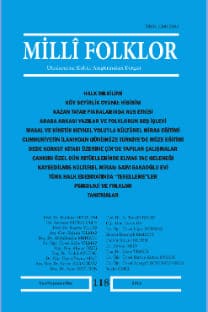BAĞLAMI VE DEDE KORKUT'U ANLAMAK: SEGREK ANASININ MI ATASININ MI AĞZINI ARADI?
ÖZ Tarihî metinlerin doğru okunması ve doğru anlaşılması hem geçmişi hem de günümüzü doğru değerlendirmemizi sağlar. Aynı zamanda okunan metinle ilgili yapılacak olan çalışmaların sağlam bir zemine oturması kolaylaşır. Bu nedenle tarihî bir metni doğru anlamak için dikkate almamız gereken önemli yöntemlerden biri bağlamı takip etmektir. Bağlamın kılavuzluğunda ilerlemek, metni doğru anlamamızı ve metinle ilgili sorunları daha kolay çözmemizi sağlar. Çünkü kelimeleri doğru okumu- yorsak sadece seslendirmiş oluruz; doğru okuyup okumadığımız konusunda bağlam bizi yönlendirir ve bu yönlendirmeyle yeni denemelere girişiriz. Okuma ve bağlam örtüştüğü zaman doğru sonuca ulaşmış oluruz. Dede Korkutun elimizdeki metinlerinin daha çok bir tiyatro eseri olarak görülmesi ve bu gözle okunması gerekir. Çünkü Dede Korkut hikâyeleri sözlü gelenekte anlatıcılar tarafından yüzyıllarca icra edilmiş hikâyelerdir. Tiyatro tarafı ağır basan bu hikâyelerde yazılı metinlerden farklı olarak çok daha sık şaşırtmaca ve sürpriz olaylara tanık oluruz. Ayrıca Dede Korkut hikâyelerinde anlatıcı oza- nın kısaltmalar kullanarak çok uzun zaman dilimlerini çok kısa ve özlü şekilde anlattığı dikkat çeker. Ancak elimizdeki metinde bu konulara dikkat edilmediğinden bir kelimenin yanlış okunması sonucu Öşün Koca Oğlu Segrek Boyunun senaryosunda anlaşılmayan birtakım sorunlar ortaya çıkmıştır. Bu sorunların çözümü için bağlam ve hikâyenin tiyatral tarafının dikkate alınması gerekir. İşte bu ma- kalede, Öşün Koca Oğlu Segrek Boyunda ata kelimesinin ana şeklinde okunması nedeniyle bağlam ve senaryoda ortaya çıkmış olan birtakım karışıklıklar, sorunlar üzerinde durulmakta ve bu sorunlara açıklamalar getirilerek teklifler sunulmaktadır. Anahtar Kelimeler
Understanding Dede Korkut and Its Context: Did Segrek Sound Out His Mother or His Father?
ABSTRACT Accurate reading and correct understanding of historical texts provides our accurate assessment of both the past and the present. At the same time, it becomes easier locating solid foundations for stu- dies on the text that will be read. Thus, one of the important methods to be considered to understand a historical text correctly is to follow context. Advancing with the guidance of the context provides us with the correct understanding of the text and therefore text-related problems become easier to tackle. Because, if we cant read the words correctly, then we just vocalize them. Context leads us to whether we read the words correctly and we take up new studies with this guidance. When reading and context overlap, we get the right result. The present text of Dede Korkut should be seen as more of a theatrical work and be read in this respect. Because Dede Korkut narratives are the stories which have been performed by narrators of oral tradition for centuries. In these stories which have the dominance of the- atrical aspect, As distinct from written texts, we witness more twisted and surprising events. Besides, it draws attention that minstrels in Dede Korkut narratives narrate long episodes shortly and concisely by using abbreviations. However, since these aspects arent considered in our text, as a consequence of misreading of a word, there arose some incoherent problems in the scenario of Öşün Koca Oğlu Segrek Boyu. It is necessary to consider the context and theatrical aspect of the story for the solution of this problem. This article elaborates some problems in the context and scenario as a result of misreading the word ata as ana in Öşün Koca Oğlu Segrek Boyu and also some suggestions are presented accounting for these problems. Keywords
___
- Ergin, Muharrem. Dede Korkut Kitabı. İstanbul: Milli Eğitim Bakanlığı Yayınları, 1971. Ergin, Muharrem, Dede Korkut Kitabı I (Giriş- Metin-Faksimile). Ankara: Türk Dil Kurumu Yayınları, 1989. Ergin, Muharrem, Dede Korkut Kitabı II (İndeks- Gramer). Ankara: Türk Dil Kurumu Yayın- ları,1991. Gökyay, Orhan Şaik. Dedem Korkudun Kitabı. İstanbul: Milli Eğitim Basımevi, 1973. Gökyay, Orhan Şaik. Dede Korkut Hikâyeleri.tanbul: Dergâh Yayınları, 1995. Özçelik, Sadettin. Dede Korkut Araştırmalar, Notlar/ Dizin/ Metin. Ankara: Gazi Kitabe- vi, 2005. Özçelik, Sadettin. Dede Korkut Üzerine Yeni Not- lar. Ankara: Gazi Kitabevi, 2006. Sultanzade, Vugar. Uşun Koca Oğlunun Kaç Kardeşi Vardı? (Dede Korkut Kitabındaki Bir Kelime Üzerine) Millî Folklor 100 (Kış 2013): 149-153. Tezcan, Semih ve Boeschoten, Hendrik. Dede Korkut Oğuznameleri, İstanbul: Yapı Kredi Yayınları, 2001. Tezcan, Semih. Dede Korkut Oğuznameleri Üze- rine Notlar. İstanbul: Yapı Kredi Yayınları: 2001. İs-
